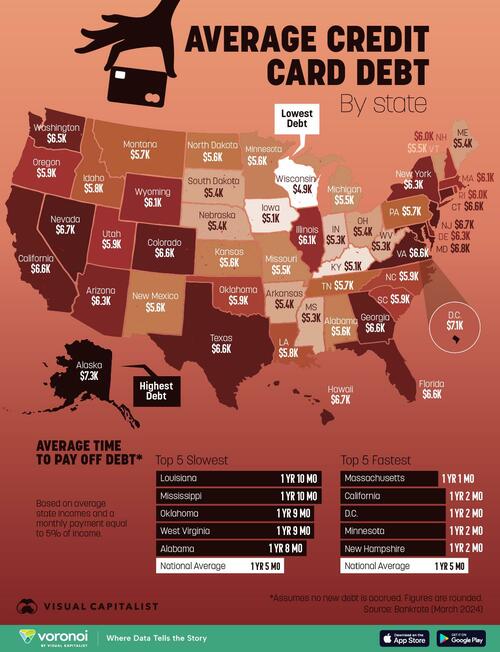Authored by Richard Truesdell and Keith Lehmann via American Greatness,
Listen to any speech given by Democrats in 2024, and you’ll be bombarded by buzzwords, sloganeering, euphemisms, and phrases that provide a constant diversion from answering truthfully.

During this election cycle, the language is changing so fast that we need this updated glossary of terms to understand exactly what they’re talking about.
Affordable Housing: Housing that is government subsidized to below-market value, ruining the value of compatible unsubsidized housing in the nearby area. So what? Ownership is oppressive and harmful to those who don’t have it. From each according to his abilities to each according to his needs. Marxism is so cool!
Anything-phobic: A tactical label given to someone who is winning an argument with a leftist. Don’t like the idea of underage children getting “gender-affirming” surgeries? You’re “transphobic.” In favor of Israel defending itself from Hamas? You’re “Islamophobic.” Concerned about the illegal mass importation of third-world peasants into the country? You’re “xenophobic.” See also “racist” below.
Bipartisan: Republicans give the Democrats everything they want so the Republicans don’t get criticized for “creating gridlock” in Congress or “shutting down” the government. Any legislation passed as being “bipartisan” has likely been drafted by Democrats and has support from a group of establishment Republicans typically in favor of the Democrats’ agenda. This indicates the presence of a “uniparty” that supports big government—and your interests don’t matter.
Brat: See “joy” below.
Climate Change: An all-inclusive label given to the Earth’s climate, which has been changing for 3.4 billion years. The theory of human-caused climate change has yet to be proven in any scientific manner, but humans are nonetheless expected to abandon their quality of life on the odd chance that our existence is killing the planet. We can’t have that, so let’s throw soup on the Mona Lisa and glue ourselves to the highway during rush hour to show how serious we are.
“Common Sense” Gun Control: Gun confiscation. There is nothing “sensible” about violating a citizen’s Second Amendment rights. It is like confiscating a person’s car because someone else used their car in the commission of a crime. This is a ploy by the government to disarm citizens as a way to exert maximum control over their lives. Don’t think it can’t happen here.
Corporate Greed: An accusation leveled at any company that turns a profit for the benefit of its shareholders. The same accusation is made toward any company raising prices due to inflation caused by destructive government economic policies. This is yet another sign that the government will not assume any accountability for its incompetence or malice.
Deincarceration: Setting convicted criminals free with the intention of closing prisons. In the eyes of the left, no human being, even the most violent and depraved, should be imprisoned and separated from the public. The chaos, destruction, and loss of life are a feature, not a bug.
Disinformation: See “misinformation” below.
Diversity: Dividing people by their immutable qualities, such as race and gender, to create conflict within a society or system for the benefit of those in power. You see, “diversity” is our strength. Just ask those who are in charge.
Equity: Equal outcome of life’s experiences, no matter how much effort or ambition is applied. A chain is as strong as its weakest link; thus a society is as strong as the most incompetent, lazy, psychopathic weirdo among us.
Existential Threat to Democracy: A person or movement that will interrupt the looting of the U.S. Treasury, the kickbacks from U.S. foreign aid to Ukraine, and massive corruption at the federal level in which elected and unelected bureaucrats emerge from “public service” fabulously wealthy for doing virtually nothing of value. See “‘our’ democracy” below.
Fair Share: The amount of taxes that “rich” people and corporations must pay as determined by the politician demanding it. The actual amount varies depending on how much influence that person or company has with the politician.
Food Desert: The lack of access to groceries due to the consistent looting of goods by neighborhood residents, with the store owner threatened with jail if he intervenes and the police instructed to stand down. Eventually, the grocery store closes due to lost profitability and the inability to obtain business insurance. Or maybe it’s just corporate greed? Yeah, that sounds better (see “corporate greed” above).
Gaslighting: The practice of leftists and progressives deluding themselves that fantasy is reality as practiced by Democrats and their handmaidens in the mainstream media. In 2024 this was especially true as practiced by CNN, MSNBC, the New York Times, and the Washington Post. To “gaslight” is to manipulate viewers and readers into questioning their perception of reality.
Harm Reduction: Providing clean drug paraphernalia for junkies and a safe area for them to shoot up or smoke up, making drug addiction almost consequence-free. That is, until the junkie ODs and winds up dead in a ditch somewhere. See, there is a cure for addiction after all.
Hate Speech: Any speech the left disagrees with.
Inclusion: The exclusion of heterosexual, white males from employment, opportunities for advancement, and participation in American society.
Investment: Spending excessive taxpayer monies on already bloated programs without any expectation of being held accountable for failure. A lot of “investments” have been made in the last four years, right?
Joy: Also “brat.” Nobody has a f*cking clue what this means.
Justice: Payback for all grievances, real or imagined. Social justice, climate justice, racial justice, and even distributive justice. Revenge for thinking or being different. This takes the place of “criminal justice,” as criminals are now considered a key voting bloc among Democrats. Why else would they want to give incarcerated felons voting rights?
Justice reform: Refusal to enforce laws that deter crime, creating societal chaos to urge citizens to give up their freedoms and allow others to control their lives in exchange for security (see “Security” below).
Malinformation: See “misinformation” below.
Marginalized communities: People who compete for benefits within the government spoils structure but don’t want to work for it, expecting social workers to guide them through the system, creating dependency. This dependency keeps them “marginalized,” and the welfare-industrial complex chugs on into perpetuity.
Minimum wage: Sometimes referred to as “living wage,” this is the mandated wage paid to entry-level workers that is above and beyond the market value those workers actually deliver, which eliminates the number of available entry-level jobs and reduces the hours (and salaries) of those who ultimately will need multiple jobs to offset their losses. At any rate, the real minimum wage is ZERO once you’ve lost your job, all good intentions notwithstanding.
Misinformation: Any statement or narrative that exposes the truth about an event or intention. Also known as “disinformation” and “malinformation.”
MSDNC: Another name for the far-left cable news outlet, MSNBC. Led by its best-known propagandist, Rachel “RussiaGate” Maddow, and supported by a cast of Democrat operatives, including Jen Psaki, Joy Reid, Mika Brzezinski, Stephanie Ruhle, Chris Hayes, Alex Wagner, and Lawrence O’Donnell, along with long-standing RINO (Republicans In Name Only) neocons like Nicole Wallace and Joe Scarborough, who gaslighted themselves. In the aftermath of the 2024 election, MSDNC proceeded to lose approximately 50 percent of its audience. DNC in MSDNC refers to the Democrat National Committee.
Newcomer: One of the over 15 million people from all over the world that have illegally descended on our nation over the past four years. Each “newcomer” immediately receives prepaid credit cards, cell phones, EBT cards, transportation, and hotel vouchers that are not available to U.S. citizens (“see Undocumented Migrant” below). The “newcomer” is to be welcomed, fast-tracked to citizenship, registered to vote, and fully supported by your tax dollars without any exception or limit.
Non-binary: A person who can’t decide if they’re straight or gay. Spoiler: If you’re a guy and you like guys, or if you’re a gal and you like gals, gay it is. You’re welcome.
Opportunity Economy: A campaign platitude that has no meaning and cannot be explained by anyone claiming this as a policy platform. Also known as a “dream economy,” in which economic recovery under Democrats exists only in a dream.
“Our” Democracy: “Our” government spoils system that we control, allowing us to reign over the population by choosing economic winners and losers, buying votes through wealth transfers, paying people to be dependent on us so we can control them, and having the ability to punish our political enemies, which, as it so happens, is about half of the country. Let’s get one thing straight: It is not “your” democracy we are saving.
Palestinian People: Mostly Jordanians who were kicked out of Jordan for attempting to overthrow the country continuously since the 1940s. The “Palestinian people” exist only as a suicide squad against Israel. One must realize that a vast majority of “Palestinians” are actually incorrigible barbarians still living under 7th-century religious and social doctrines that even the surrounding Arab nations cannot control and thus refuse to take into their countries.
Path to Citizenship: Blanket amnesty.
Privilege: Something for White people to “check.” We keep “checking,” but we can’t find it.
Progressive: A weasel word for a communist-curious, poorly educated radical with no impulse control and only a slight relationship with reality. When in power, the progressive wants to preserve the status quo. Out of power, the progressive tries to overthrow the opposition by any means necessary. The label has nothing to do with “progress,” but word games are fun, and they hate themselves anyway, so let them run with that label.
Public servant: A noble, dedicated government figure who tirelessly works on behalf of the people. A person who also, under any circumstance, cannot be terminated in most cases, who will walk off the job in a New York minute if the union says so, has every single federal and local holiday off with pay and has a government pension that will continue to pay out a nearly full annual salary with benefits upon retirement for the rest of the “public servant’s” life. It’s a career path for those who otherwise would be unemployable.
Racist: A label slapped on any action or statement that a leftist cannot handle or answer honestly. It’s a coping mechanism for the left, rendering the genuine meaning of “racist” useless.
Reproductive freedom: The position that a woman should have complete and total freedom to kill her unborn child, even in the delivery room. It’s her body and her choice, you sexist pig.
Security: A prohibition of self-defense where citizens defending themselves or others will be punished while non-citizens and the “marginalized” will be set free and rewarded with taxpayer benefits. All in the name of “social justice” (see “justice” above).
Transgender: Formally known as “gender dysphoria,” which elevates a person to near the top of the victim pyramid, and everyone must play along with the person’s break from reality and call that person by their preferred pronoun, or you will lose your job and everything you own. Our pronouns are Screw/You.
Underrepresented: An ethnic group that, in the opinion of politicians, doesn’t have enough power over other people.
Undocumented immigrant: A brave, admirable new member of society offering cultural enrichment, doing the jobs Americans won’t do, and living in the U.S. as a net-positive influence on our society. Documents should not matter, because no human being should be considered “illegal.” We’re pleased to have you, just not living in our neighborhood.
Word Salad: A stunningly absurd response to a straight-up inquiry, consisting of conjoined sentences and non-sequiturs containing zero substance. Words are repeated to indicate seriousness, yet it only reinforces the notion that the speaker has no idea what they are talking about. If it were a cuisine, it would be a popular item at the Democrat Diner.
Workers’ Rights: A label given to the activity of a union’s coercion of workers to organize, pay union dues, and vote the way the union bosses want them to vote. The only “workers’ rights” the union cares about are the ability to strike at the direction of the union and to authorize massive pay packages for the union leadership. The workers are otherwise expendable.










